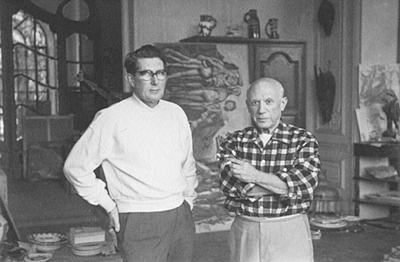Listing page content here
It was not easy to be an attendant at the court of King Pablo, for Picasso, ‘with his fringe of white hair round the back of his head, his never tiring black eyes, his red shirt, is always the centre of everyone’s thoughts, especially as everyone else’s movements depend on his and no one, not even he, knows what it will be’. It was no easier to be King Pablo:
P. wanting everyone to enjoy themselves started making masks with the tablecloths and most of the guests put them on, but some began to smuggle them under the table as valuable souvenirs. P., seeing this, looked around with an angry face and, collecting all the masks, crumpled them up and threw them into the sea.
When his every doodle brought the price of a good-sized house, it was hard to separate genuine friends from vultures waiting to feed off the artist’s leavings.
Roland Penrose, sometime artist, full-time writer and exhibition organiser, met Picasso in 1936 and remained an ardent friend, supporter and supplicant until Picasso’s death in 1973. Picasso was the love of his life, the reason for his professional existence — and perhaps, even, his personal one. According to a colleague, Penrose was ‘in love with Picasso, passionately, and he put Picasso before everybody and everything’, including Penrose’s photographer wife Lee Miller. Elizabeth Cowling, who has mined the diaries, letters, photographs and notebooks that make up the Penrose Archive in the Scottish National Gallery of Modern Art to create this ‘biography of a friendship’, calls their intertwined story a ‘tale of courtly love’, where Penrose ‘was the active protagonist … who initiated the contact, did the travelling, the writing and the calling’, with Picasso ‘all-powerful and Penrose prostrate at his feet’. Yet ‘ultimately it was Penrose who triumphed through the sheer tenacity of his dedication. What might have been a sad tale of failure and humiliation is actually a tale of rare fulfilment and substantial rewards’. It is this tale she unfolds for us in the elegantly designed and beautifully illustrated Visiting Picasso.
In the 1920s Penrose studied art in Paris, under André Lhôte, an admirer of Picasso. He then married Valentine Boué, a poet and friend of the Surrealists, and through her became friends with Max Ernst, André Breton and Paul Eluard. In 1937 he was a prime mover in the great Surrealist exhibition held in London (where Dali lectured in a deep-sea diver’s suit). That same year, he bought his first Picasso, and soon he had the most important collection of Picassos in Britain, as well as pictures by Ernst, de Chirico, Dali, Miró and others. By the end of the war, Penrose had given up painting except for his own pleasure, and instead devoted his life to making modern art accessible and comprehensible. He founded the ICA, and, most importantly, championed his hero to such a degree he became known in the press as ‘the Picasso Man’.
It is difficult to remember today just how odd and difficult Picasso seemed in Britain as late as the 1950s. And the shift, from ignorant mockery to an acceptance of the artist as the titan of modern art, was in great part owing to Penrose, through his books (Portrait of Picasso, 1956, Picasso, His Life and Work, 1958) and exhibitions (an exhibition of Guernica in 1938-9, Picasso Himself in 1956, a retrospective at the Tate in 1960, an exhibition of sculpture and ceramics in 1967, of engravings in 1970, and Picasso’s Picassos in 1981). To this end, he spent time with Picasso, corresponded with Picasso, interviewed Picasso’s friends and family. There are descriptions of Picasso’s houses, interpretations of works in progress, stories of friends, family, lovers and hangers-on, as well as accounts of the exhausting spadework that went into mounting an exhibition, or even just purchasing a painting.
Penrose ‘translated’ Picasso for the British public, and Elizabeth Cowling shows just how much anguish went into this Herculean task, how much hurt, how much rejection Penrose absorbed in the pursuit of his aim — the greater glory of Picasso. Yet there were also rewards: Picasso once told of a recurring anxiety dream, in which he arrived in England with no money. The distress was dispelled only when he dreamed that he ‘decided to search for his friend Penrose’. At times Penrose can sound like a schoolgirl with a crush. But while not many ages are fortunate enough to have heroes like Picasso, even fewer heroes are blessed with hero-worshippers of such integrity and seriousness of purpose as Penrose.






Comments